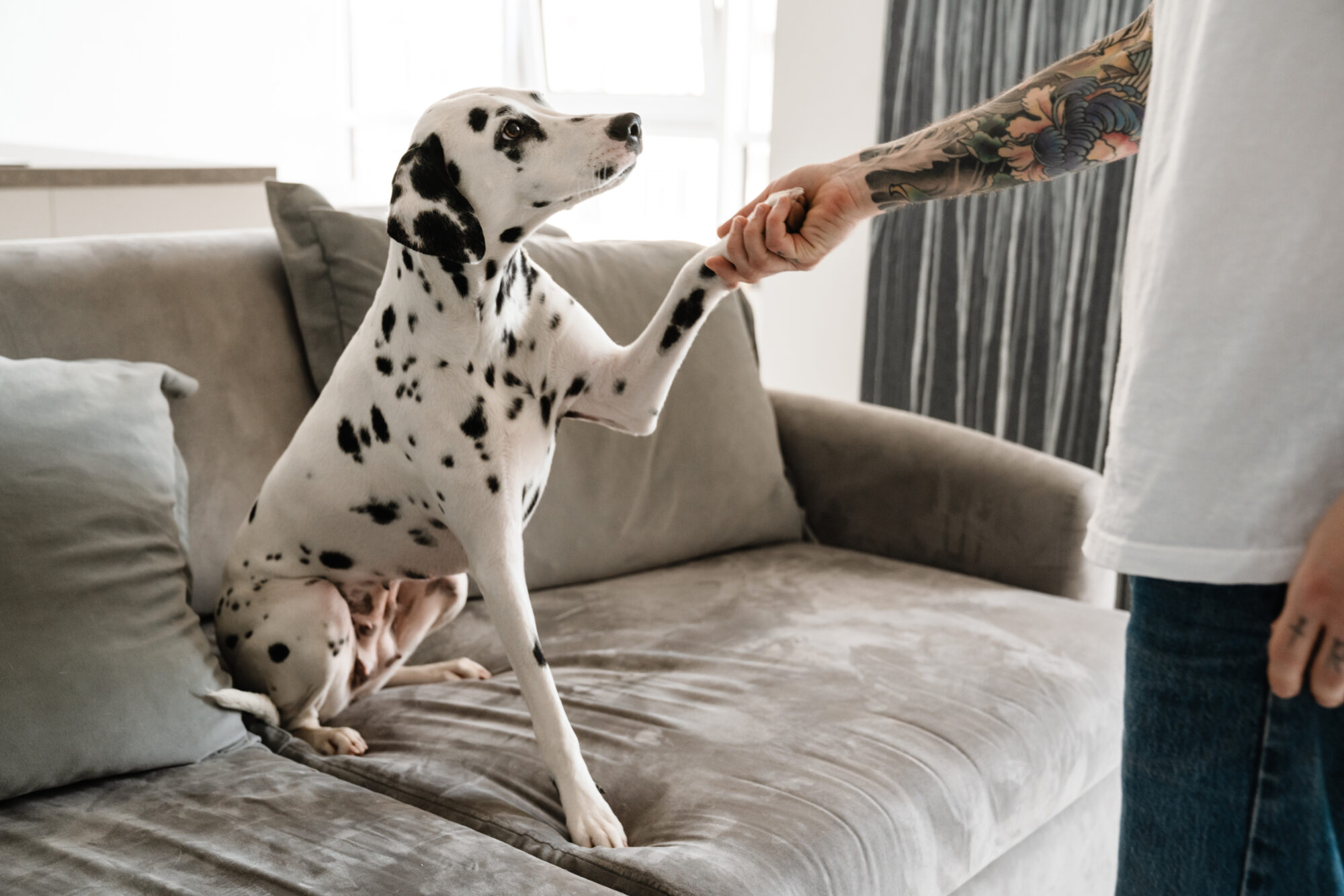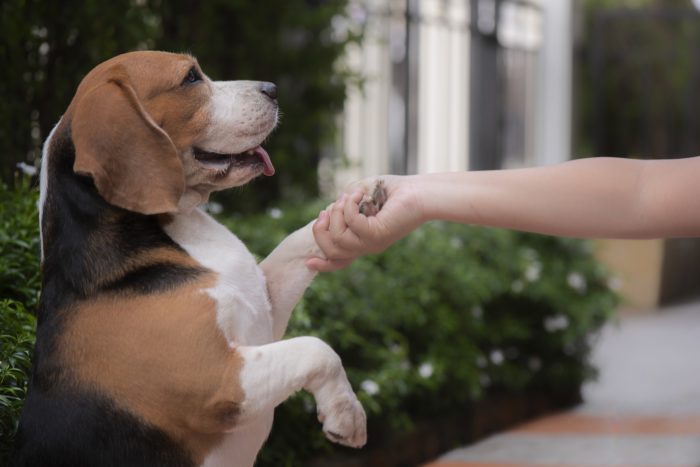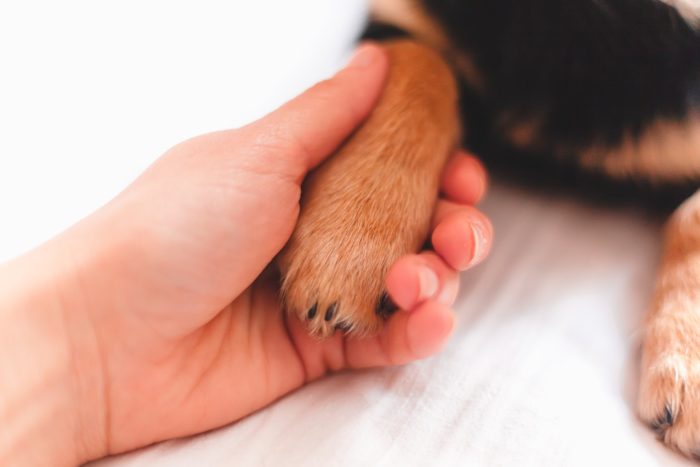Shake! How to teach a dog to give paw?
Teaching your dog to give a paw is a simple, fun trick which, as well as looking cute, also has practical applications. Offering a paw can be a polite way for dogs to greet people since they are usually sitting when they offer this behaviour and if they’re sitting they can’t be jumping! Using positive reinforcement techniques to teach your dog to voluntarily offer a paw makes this a behaviour the dog is comfortable and confident doing which can make essential husbandry procedures like nail clipping much less stressful for your dog and so much easier for you. So how to teach a dog to give paw?
There are various ways to teach this behaviour but I like to use a combination of shaping (rewarding successive approximations towards a goal behaviour) and targeting (teaching your dog to touch an object with a part of his body).
How to teach a dog to give paw?
To teach dog to give paw the first thing I do is teach my dog to touch another object – not my hand – with his paw. A small, flat object which I can easily hold in my palm works best. Something like a coaster or a small plastic lid or even a Post-It note works well.
Some dogs use their paws naturally to investigate new objects. For them, simply placing the target on the ground in front of them is often enough to make them reach out to touch it. If they do click any movement of a paw towards the target & follow up with a treat. Remove the target after each click & re-present it for each new repetition. Gradually shape the behaviour until your dog is touching the target every time. I like to present the target to both the right and left of my dog to encourage them to use both paws. This helps keep them physically balanced and keeps the paw target behaviour flexible. This is a good way to teach a dog how to give a paw.
How to teach paw cue?
Other dogs may need a little more encouragement so you can increase interest in the target by placing a treat on the floor and then covering it with the target. Your dog is likely to sniff or paw at the target to try to get the treat. As soon as there is any movement of the paw towards the target click and remove the target to allow your dog to get the treat. Repeat until your dog is reliably touching the target with his paw. You can than repeat without the treat under the target. This is important when training your dog.
Now that your dog is reliably touching the target with his paw we can start to transfer the behaviour from the target object to our hand. Start by holding the target in the palm of your hand and place the back of your hand on the floor in front of your dog. If your dog paws the target click and treat. Repeat, gradually raising your hand from the floor. Present the target in both hands to encourage your dog to use both right and left paws to hit the target.
How to teach a dog to shake hands?
Once your learner is reliably touching the object in your outstretched hand you can begin to fade out the target. The simplest way to do this is to make it smaller. If I’m using a Post-It note I just keep folding it in half, making it less and less significant, until I can remove it altogether.
Now that you have a fluent, reliable behaviour of your dog touching your outstretched palm with his paw you can add your cue. Your cue is the signal to your dog that reinforcement is available for the requested behaviour. You could just use “paw” but why not have some fun with your cue? How about “shake” or “how do you do” or “nice to meet you”. Get creative when you teaching your dog to give paw!
How to teach a puppy to give paw?
Give your chosen cue just before the behaviour starts and click as the behaviour is happening. Repeat to consolidate the connection between the cue and the behaviour.
Good stimulus control – meaning your dog will only give a behaviour when asked and won’t offer a behaviour in response to other cues – is important for all behaviours but, I think, especially for behaviours where the dog is being asked to make contact with a person. Having a dog trying to place his paw on a person without being cued could be problematic.
So getting the “paw” behaviour under strong stimulus control is important. Strengthen your cue by giving it in different locations – different rooms in your home, inside, outside, in the garden, out on walks. And vary your own position – deliver your cue sitting down, standing up, sitting on the floor etc. Alternate your “paw” cue with other known cues. All of these things will help build both a strong cue and strong stimulus control.
Now that you have taught a fluent paw touch behaviour you can use this as a foundation to build other behaviours. By varying your hand position you can teach a High 5. By building in movement you can teach a wave. By selecting only certain responses you can teach your dog to discriminate between his left paw and his right paw.
At first glance paw is just a simple “trick” behaviour. But it’s a great introduction to targeting for both dogs and trainers with many applications and variations. Give it a go!
Before you go! Do you know we have dog training courses? No?! Take a look! *Wow! I want to check it now! – click here*
See also other posts:
June 30, 2023
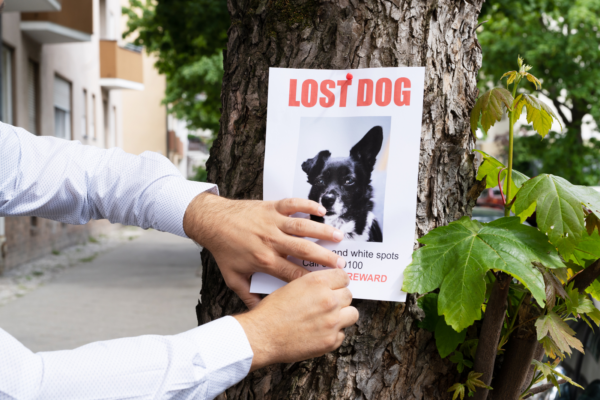
Get Your Lost Dog Back Home Quickly: Follow These 12 Tips for Success
Vacations favor more frequent and longer walks with our furry friends. We travel, visit new places. Summer makes us loosen our brakes and allow our…
June 30, 2023
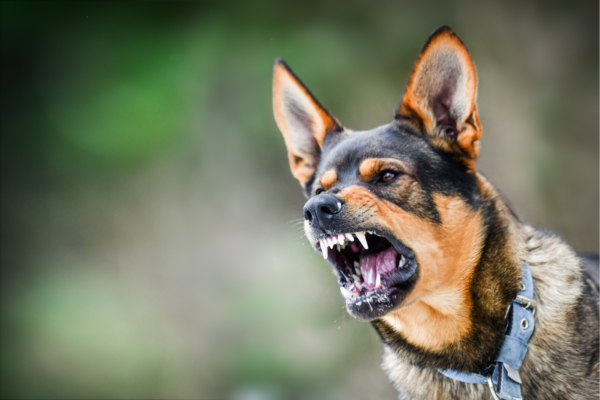
Managing Aggressive Dog Behavior: Tips for Peaceful Living
Living with an aggressive dog may seem challenging, but it can be peaceful and manageable with the right approach. One key aspect is to remain…
June 30, 2023
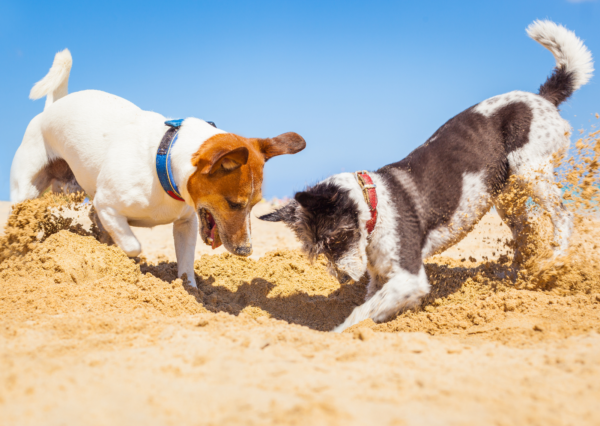
Unlocking the Secret to Successful Puppy Socialization: Quality over Quantity
Today, although the topic is very important, I will keep it brief. Socialization is a topic that could fill books or scientific papers. However, today…

